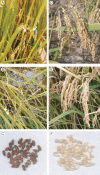The complex history of the domestication of rice - PubMed (original) (raw)
Review
The complex history of the domestication of rice
Megan Sweeney et al. Ann Bot. 2007 Nov.
Abstract
Background: Rice has been found in archaeological sites dating to 8000 bc, although the date of rice domestication is a matter of continuing debate. Two species of domesticated rice, Oryza sativa (Asian) and Oryza glaberrima (African) are grown globally. Numerous traits separate wild and domesticated rices including changes in: pericarp colour, dormancy, shattering, panicle architecture, tiller number, mating type and number and size of seeds.
Scope: Genetic studies using diverse methodologies have uncovered a deep population structure within domesticated rice. Two main groups, the indica and japonica subspecies, have been identified with several subpopulations existing within each group. The antiquity of the divide has been estimated at more than 100 000 years ago. This date far precedes domestication, supporting independent domestications of indica and japonica from pre-differentiated pools of the wild ancestor. Crosses between subspecies display sterility and segregate for domestication traits, indicating that different populations are fixed for different networks of alleles conditioning these traits. Numerous domestication QTLs have been identified in crosses between the subspecies and in crosses between wild and domesticated accessions of rice. Many of the QTLs cluster in the same genomic regions, suggesting that a single gene with pleiotropic effects or that closely linked clusters of genes underlie these QTL. Recently, several domestication loci have been cloned from rice, including the gene controlling pericarp colour and two loci for shattering. The distribution and evolutionary history of these genes gives insight into the domestication process and the relationship between the subspecies.
Conclusions: The evolutionary history of rice is complex, but recent work has shed light on the genetics of the transition from wild (O. rufipogon and O. nivara) to domesticated (O. sativa) rice. The types of genes involved and the geographic and genetic distribution of alleles will allow scientists to better understand our ancestors and breed better rice for our descendents.
Figures
Fig. 1.
Wild and domesticated rice phenotypes. (A) Immature panicle from O. rufipogon showing open panicle structure; arrows indicate extruded stigmas. (B) Mature panicle from O. rufipogon showing dark hulls and long awns; arrows indicate positions of seeds that have shattered. (C, F) Dehulled seed from O. rufipogon (C) and O. sativa (F). (D, E) Grain-bearing O. sativa ssp. japonica (D) and ssp. indica (E) panicles with straw-coloured hulls with a closed panicle structure.
Similar articles
- Archaeological and genetic insights into the origins of domesticated rice.
Gross BL, Zhao Z. Gross BL, et al. Proc Natl Acad Sci U S A. 2014 Apr 29;111(17):6190-7. doi: 10.1073/pnas.1308942110. Epub 2014 Apr 21. Proc Natl Acad Sci U S A. 2014. PMID: 24753573 Free PMC article. - Estimation of loci involved in non-shattering of seeds in early rice domestication.
Ishikawa R, Nishimura A, Htun TM, Nishioka R, Oka Y, Tsujimura Y, Inoue C, Ishii T. Ishikawa R, et al. Genetica. 2017 Apr;145(2):201-207. doi: 10.1007/s10709-017-9958-x. Epub 2017 Feb 25. Genetica. 2017. PMID: 28238052 - New insights into the history of rice domestication.
Kovach MJ, Sweeney MT, McCouch SR. Kovach MJ, et al. Trends Genet. 2007 Nov;23(11):578-87. doi: 10.1016/j.tig.2007.08.012. Epub 2007 Oct 25. Trends Genet. 2007. PMID: 17963977 Review. - Contrasting patterns in crop domestication and domestication rates: recent archaeobotanical insights from the Old World.
Fuller DQ. Fuller DQ. Ann Bot. 2007 Nov;100(5):903-24. doi: 10.1093/aob/mcm048. Epub 2007 May 10. Ann Bot. 2007. PMID: 17495986 Free PMC article. Review.
Cited by
- Rice-specific Argonaute 17 controls reproductive growth and yield-associated phenotypes.
Pachamuthu K, Swetha C, Basu D, Das S, Singh I, Sundar VH, Sujith TN, Shivaprasad PV. Pachamuthu K, et al. Plant Mol Biol. 2021 Jan;105(1-2):99-114. doi: 10.1007/s11103-020-01071-2. Epub 2020 Sep 22. Plant Mol Biol. 2021. PMID: 32964370 - Musings about the effects of environment on photosynthesis.
Lawlor DW. Lawlor DW. Ann Bot. 2009 Feb;103(4):543-9. doi: 10.1093/aob/mcn256. Ann Bot. 2009. PMID: 19205084 Free PMC article. - High-throughput sequencing and mutagenesis to accelerate the domestication of Microlaena stipoides as a new food crop.
Shapter FM, Cross M, Ablett G, Malory S, Chivers IH, King GJ, Henry RJ. Shapter FM, et al. PLoS One. 2013 Dec 18;8(12):e82641. doi: 10.1371/journal.pone.0082641. eCollection 2013. PLoS One. 2013. PMID: 24367532 Free PMC article. - Haplotype and diversity analysis of indigenous rice for salinity tolerance in early-stage seedling using simple sequence repeat markers.
Mohanavel V, Yesudhas AS, Sharma A, Ramasamy A, Muthu Arjuna Samy P, Subramanian M, Muthusamy R. Mohanavel V, et al. Biotechnol Rep (Amst). 2021 Aug 9;31:e00666. doi: 10.1016/j.btre.2021.e00666. eCollection 2021 Sep. Biotechnol Rep (Amst). 2021. PMID: 34557392 Free PMC article. - Advances in Rice Seed Shattering.
Wu H, He Q, Wang Q. Wu H, et al. Int J Mol Sci. 2023 May 17;24(10):8889. doi: 10.3390/ijms24108889. Int J Mol Sci. 2023. PMID: 37240235 Free PMC article. Review.
References
- Blench R. Archaeology, languages, and the African past. Lanham: Alta Mira Press: 2006. pp. 217–219.
- Bres-Patry C, Lorieux M, Clement G, Bangraz M, Ghesquiere A. Heredity and genetic mapping of domestication-related traits in a temperate japonica weedy rice. Theoretical and Applied Genetics. 2001;102:118–126.
- Cai W, Morishima H. QTL clusters reflect character associations in wild and cultivated rice. Theoretical and Applied Genetics. 2002;104:1217–1228. - PubMed
- Cao ZH, Ding JL, Hu ZY, Knicker H, Kogel-Knabner I, Yang LZ, et al. Ancient paddy soils from the Neolithic age in China's Yangtze river delta. Naturwissenschaften. 2006;93:232–236. - PubMed
- Chang KC. The archaeology of ancient China. New Haven, CT: Yale University Press; 1986.
